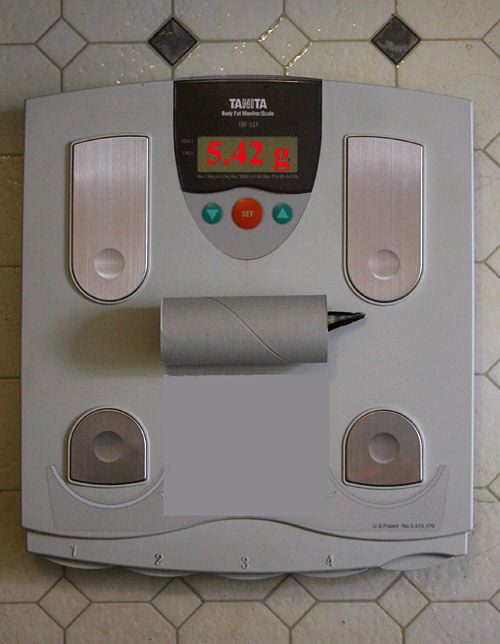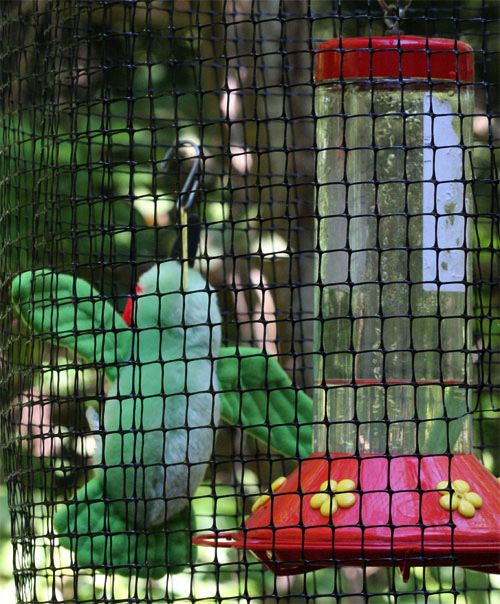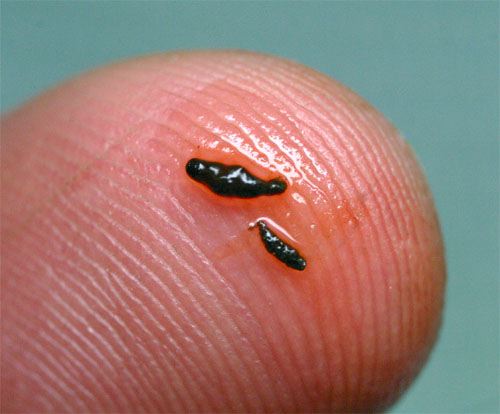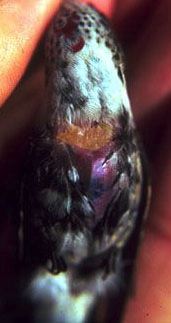|
|
|||
|
(Back to Preceding Week; on to Next Week) |
|
|
|
"BIG FAT": In recent years there have been many studies and newspaper articles describing an epidemic of obesity across the country. This is no laughing matter, of course, and is a health problem of national concern--especially among children. As recommended by everyone from family doctors to the Surgeon General and the President of the United States, we all need to get more exercise and eat less and more wisely. A slimmer America undoubtedly would be a healthier America. Unfortunately, the obesity epidemic appears to have leapt from humans to hummingbirds. A few days ago we caught a REALLY big hummer, a bird that felt and looked substantially fatter than any we had ever handled before. Our 25 years of hummer banding at Hilton Pond Center seem to indicate Ruby-throated Hummingbirds have been getting bigger . . . and bigger . . . and bigger--at least in fall--so to verify this alarming trend we checked an archive of e-mail postings we have made since 2000 concerning autumn weight gain in hummingbirds. Read on to learn the chronological saga of an apparent obesity epidemic plaguing "Big Fat" and his descendants. All text & photos © Hilton Pond Center "BIG FAT" In our many years of studying Ruby-throated Hummingbirds at Hilton Pond Center, only once have we named a bird we have banded. The bird in question is outside our kitchen window right now. A young male, he is perched on a trap, blocking the entire entrance with his sausage-like body. We call him "Big Fat." "Big Fat" has been hogging the feeders for weeks. He now resembles Jabba the Hutt (right) from Star Wars, or maybe a sumo wrestler with feathers. "Big Fat" is banded and has a necklace of green dye. Assuming he can get clearance from the FAA, he should be taking off soon for the tropics. If you live south or west of Hilton Pond, please look for "Big Fat" during migration. You will recognize him easily. He is roughly the size of the Goodyear blimp. WARNING: When "Big Fat" comes to your feeder, please do not call him by that name unless you are willing to suffer the consequences. Instead, we suggest you call him "Sir!" Largely yours, BANDER OF OBESE HUMMINGBIRDS - - - - - - - - - - - - - - - - - - - - - - - - - - - - - - - - - - - - - - - - - - - "BIG FAT" A young male Ruby-throated Hummingbird typically registers about 3.0g prior to migratory weight gain. "Big Fat" was already a tubby on 17 September when we first caught him. That day, he weighed 4.31g. We caught "Big Fat" again in a mist net on 20 September and he was already up to 5.10g. That's a 15% weight gain in only three days!
Stoutly yours, BANDER OF OBESE HUMMINGBIRDS "SON OF BIG FAT" On 30 July 2003 we captured a young male Ruby-throated Hummingbird that weighed a hefty 3.62g--on the heavy side among mid-summer males we've banded here at Hilton Pond Center. We should have known just by looking at this bird he was already in training for the Autumnal Hyperphagic Olympics*. We caught him again three days ago (6 Sep) and he already weighed in at a svelte 4.55g.
All text & photos © Hilton Pond Center When we retrapped him today (9 Sep) he had gained another 1.4g and tipped--make that crushed (sproing!)--the scales at 5.95g (above, accounting for weight of tube). Imagine increasing your body weight by almost 20% in three days! We dubbed him "Son of Big Fat," in honor of a similarly rotund ruby-throat we wrote about back in September 2000 (see above). "Son of Big Fat" becomes the biggest, fattest, roundest hummer we've ever encountered. (We're thankful we were wearing a back brace when we handled him.) With corpulence in mind, BANDER OF OBESE HUMMINGBIRDS * Hyperphagia (hy-per-pha-gia). n. 1. Abnormally increased appetite for and consumption of food. 2. Clinical term for overeating. "GRANDSON OF BIG FAT"
In fact, when we got closer to the net we could see it had been shaken by what at first appeared to be a golf ball. Instead, it turned out to be a member of the Royal Rotundity--a morbidly obese Ruby-throated Hummingbird weighing down the bottom shelf of the net. Almost spherical in shape, this heavyweight winged wonder practically fell from the net into the hand, its potbellied body far too large to become snared just by the mesh. After we grasped the hummer, we were careful to lift with our legs rather than our back, less this oversized trochilid cause problems in our lumbar region. The big bird's throat was marked with dark green streaks; such a five o'clock shadow indicated it was a young male--a fact verified by the pointed tip on its sixth primary feather and a few red gorget feathers just coming in. There was no way this ponderous bird would fit into the standard paper tube we use to secure hummers for banding, so we created one to accommodate his girth. We may be exaggerating, but the new device seemed almost as big as a toilet paper tube (left). As we gingerly lowered the "hummer-in-a-tube" onto the scale, the device creaked and groaned but finally stabilized enough for us to check the read-out: 5.42 grams! This isn't the fattest or heaviest Ruby-throated Hummingbird we've ever caught at Hilton Pond--"Son of Big Fat" is the record holder to date (see above)--but he was pretty darned heavy nonetheless, and well worthy of the title "Grandson of Big Fat."
Happy Heavy Hummingbird Watching! BANDER OF OBESE HUMMINGBIRDS THE ULTIMATE "BIG FAT" On the morning of 24 September we were pondering how 2009 had started out so slowly with regard to hummer banding at Hilton Pond Center. We also were thinking about how "normal" most of our recent captures had been with regard to weight; usually by late September at least a few Ruby-throated Hummingbirds we catch are showing weight gain from body fat stored for the upcoming migration. And, as always in autumn, our mind drifted to memories of "Big Fat" and later generations of heavyweight hummingbirds we've encountered through the years. Perhaps we were just being prescient with our day-dreams because that very afternoon we noticed unusual activity in one of the hummer traps hanging from a shepherd's crook outside our office window at Hilton Pond Center.
All text & photos © Hilton Pond Center The trap's occupant was big and long-billed (above)--we thought at first we'd captured a Green Heron or maybe a Keel-billed Toucan--but, no, when we got close to the trap we could see the bird in question was an enormous immature male Ruby-throated Hummingbird with heavy throat streaking and two red gorget feathers. Although we're not sure how this humongous hummer got into the trap--after all, the entry door was only 4" x 5"--get in he did. And he was waiting for us . . . with a glint in his eye and maybe a little pent-up anger in his chunky not-so-little hummingbird heart. This is one time we were grateful we're relatively ambidextrous in handling birds, for it took all our strength and both hands to wrestle the husky hummingbird out of his enclosure. We finally subdued him, however, and got ready to carry the oversized hummer from trap to banding table. We used a hydraulic jack to get the husky hummingbird up onto the banding table, where we made ready to measure and band him. Although there was no question he was 'way too fat to fit in our standard three-quarter-inch diameter weighing tube, a 50-gallon drum was a tad large; we ended up creating a custom tube from industrial-strength duct tape and a couple of sheets of poster paper and slid in the dumpy bird. We thought we might have to weigh the now-secured hummer at the local truck stop where over-the-road scales would accommodate him, but after several tries finally managed to get a reading on our desktop electronic balance. The stunning result: 6.15g. Think of it! 6.15g! That's more than a nickel that weighs 5g!
It's hard for us to imagine a male Ruby-throated Hummingbird weighing 6.15g. As noted above, before they fatten up male ruby-throats only weigh about 3.0g or so, meaning this newest big hummer might have doubled his weight in preparation for migration. This is remarkable when we consider that under "normal" (i.e., non-migratory) conditions, only about 5% of a hummer's weight consists of fat. When hummingbirds are on their breeding or wintering grounds, they feed on flower nectar and sugar water as a source of carbohydrates that fuel their daily activities. Of course, they also need the other two basic food groups--fats and proteins--which they use to make new muscles cells and feathers and provide longer-term energy. Even during normal sleep a hummer needs a little fat; the carbs the bird gets from your sugar water feeder would burn up long before night is over. This is probably why hummers we recapture more than once in a day are almost always heavier at dusk than at noon.
Most of the year hummingbirds spend most of their time just sitting; come autumn they go into hyperphagia and feed almost constantly during daylight hours. They may make lots of feeder visits, but this is merely to take in enough sugar water to fuel insect-gathering activities. As noted in the messages above about "Big Fat" and his relatives, hyperphagic activity has the potential to increase a hummingbird's weight by 15-20% or more in two or three days--certainly an example of binge-eating. Hummingbirds store energy as yellow fat--the same oily stuff you may have noticed when preparing a chicken for the table--that burns off evenly and efficiently during migration. This fat is laid down primarily in the furcular region (wishbone) as illustrated below right, Here at Hilton Pond Center in northcentral South Carolina we don't often get heavyweight hummers like "Big Fat"; when we do it's always in mid- to late September. We suspect this far north a lot of Ruby-throated Hummingbirds don't make the effort to fatten up, instead moving southward in short hops that allow them to refuel along the way. When they get to the Gulf Coast, however, they're obligated to become hyperphagic and store enough fat to make the long trip across the Gulf of Mexico--or perhaps through unfamiliar territory if they go overland through Mexico. (NOTE: The actual southbound route for migratory ruby-throats is still a matter of speculation. Our on-going banding efforts in Central America may eventually help us solve this mystery. The northbound path is also not clear, nor do know for sure whether ruby-throats are hyperphagic prior to embarking for their trip back north in spring.)
All text & photos © Hilton Pond Center Because we don't capture many obese hummers like "Big Fat," you'll understand our excitement and amazement at our recent encounter with the "ultimate" Ruby-throated Hummingbird that tipped and almost broke the scales at 6.15g. This bird looked fatter, felt fatter, and WAS fatter than any hummer we've handled in our 25 years of banding ruby-throats at Hilton Pond Center. We've thought a long time about what to call this butterball of a ruby-throat but decided since you have waded this far through our partly tongue-in-cheek photo essay about hummingbird corpulence, perhaps YOU have a suggestion. If you do, send it on to us at INFO and we'll post the best nicknames with our next installment of "This Week at Hilton Pond." With appropriate gravity, BANDER OF OBESE HUMMINGBIRDS All text & photos © Hilton Pond Center Comments or questions about this week's installment?
Thanks to the following fine folks for recent gifts in support of Hilton Pond Center for Piedmont Natural History and/or Operation RubyThroat: The Hummingbird Project. Your tax-deductible contributions allow us to continue writing, photographing, and sharing "This Week at Hilton Pond." (Please see Support if you'd like to make a gift of your own. You can also contribute by ordering an Operation RubyThroat T-shirt.)
Using Network for Good via Facebook's "Causes," 11 people have made contributions to "Help the Hummingbirds" in honor of Bill Hilton Jr.'s 63rd birthday and bringing the total to $456--short of the $1,260 goal but nice nonetheless. Even though 15 September 2009 has come and gone, you can still donate to this birthday cause by going to Facebook. "This Week at Hilton Pond" is written & photographed You may wish to consult our Index of all nature topics covered since February 2000. You can also use our on-line Hilton Pond Search Engine at the bottom of this page. For a free, non-fattening, on-line subscription to |
|
Make direct donations on-line via
Network for Good: |
|
|
Use your PayPal account
to make direct donations: |
|
|
If you like to shop on-line please become a member of iGive, through which more than 750 on-line stores from Amazon to Barnes & Noble, L.L. Bean to Lands' End--and even iTunes!--will donate a percentage of your purchase price in support of Hilton Pond Center and Operation RubyThroat. For every new member who signs up and makes an on-line purchase iGive will donate an ADDITIONAL $5 to the Center. You can even do Web searches through iGive and earn a penny per search for the cause! Please enroll by going to the iGive Web site; more than 200 members have signed up to help. It's a painless, important way for YOU to support our on-going work in conservation, education, and research. By the way, if you add the iGive Toolbar to your browser and register Operation RubyThroat as your preferred charity, it'll be even easier to help Hilton Pond when you shop. |
|
|
SPECIES BANDED THIS WEEK: * = New species for 2009 WEEKLY BANDING TOTAL 7 species 17 individuals YEARLY BANDING TOTAL (2009) 51 species 1,553 individuals 28-YEAR BANDING GRAND TOTAL (since 28 June 1982, during which time 170 species have been observed on or over the property) 124 species 53,435 individuals |
OTHER NATURE NOTES OF INTEREST
NOW is the time to report your RTHU fall departure dates from the U.S. & Canada, and fall arrival dates for Mexico & Central America. Please participate. |
|
|
|
(Back to Preceding Week; on to Next Week) Up to Top of Page Back to This Week at Hilton Pond Center Current Weather Conditions at Hilton Pond Center |
 You can also post questions for The Piedmont Naturalist |
Join the |
Search Engine for |
|
|
Tulsa

 Like sumo wrestlers, he is surprisingly agile; he has no trouble driving away competitors.
Like sumo wrestlers, he is surprisingly agile; he has no trouble driving away competitors. Just eyeballing him at the feeder, we'd say "Big Fat" now weighs about a metric ton, give or take 999,994g. And, in one of life's small ironies, this afternoon the REAL Goodyear air ship (above left) actually flew over Hilton Pond, probably on its way to a sporting event in Charlotte NC. Or maybe it was attracted by the possibility of mating with a blimp-like "Big Fat" as he hovered around our hummingbird feeders.
Just eyeballing him at the feeder, we'd say "Big Fat" now weighs about a metric ton, give or take 999,994g. And, in one of life's small ironies, this afternoon the REAL Goodyear air ship (above left) actually flew over Hilton Pond, probably on its way to a sporting event in Charlotte NC. Or maybe it was attracted by the possibility of mating with a blimp-like "Big Fat" as he hovered around our hummingbird feeders.
 Last evening--just at sunset--one of the 25mm mist nets outside the old farmhouse at Hilton Pond Center shook noticeably, and poles at either end quivered for a moment or two. Since we've been capturing various fall migrants as of late, we suspected another Summer Tanager (above right) or Swainson's Thrush had struck the net, so we were quite surprised we couldn't see one of these relatively large birds as we approached the net lane.
Last evening--just at sunset--one of the 25mm mist nets outside the old farmhouse at Hilton Pond Center shook noticeably, and poles at either end quivered for a moment or two. Since we've been capturing various fall migrants as of late, we suspected another Summer Tanager (above right) or Swainson's Thrush had struck the net, so we were quite surprised we couldn't see one of these relatively large birds as we approached the net lane. As we took the heavyset hummer to the banding room, we practically had to fling the door all the way open to get our oversized capture across the threshold, after which we correctly determined we would need a 300-pound capacity bathroom scale (left) to weigh him.
As we took the heavyset hummer to the banding room, we practically had to fling the door all the way open to get our oversized capture across the threshold, after which we correctly determined we would need a 300-pound capacity bathroom scale (left) to weigh him. When we released "Grandson" after banding we were standing on the back deck about eight feet off the ground. This turned out to be quite fortunate, for after leaving the hand this nearly spherical bird (above right) rapidly lost altitude and needed every bit of those eight feet to gain enough airspeed to achieve stable flight. If he so chooses, "Grandson" likely has enough yellow fat to fly non-stop to the Yucatan and maybe even on to Rio for Carnaval. This was one BIG bird.
When we released "Grandson" after banding we were standing on the back deck about eight feet off the ground. This turned out to be quite fortunate, for after leaving the hand this nearly spherical bird (above right) rapidly lost altitude and needed every bit of those eight feet to gain enough airspeed to achieve stable flight. If he so chooses, "Grandson" likely has enough yellow fat to fly non-stop to the Yucatan and maybe even on to Rio for Carnaval. This was one BIG bird.
 For safe transport we usually place each hummingbird in a small lingerie bag, but for this paunchy bird we briefly considered using a pillowcase; eventually we did manage to squeeze his tubbiness into the standard bag (left). (It's fortunate we had a hand truck handy with which we could roll our beefy bird-in-the-bag into the Center's old farmhouse for processing.)
For safe transport we usually place each hummingbird in a small lingerie bag, but for this paunchy bird we briefly considered using a pillowcase; eventually we did manage to squeeze his tubbiness into the standard bag (left). (It's fortunate we had a hand truck handy with which we could roll our beefy bird-in-the-bag into the Center's old farmhouse for processing.) Amazing. Imponderable. Essentially unbelievable. This 6.15g reading was FAR more than the 5.10g weight we got for "Big Fat," more than the 5.42g achieved by "Grandson of Big Fat," and even more than the breathtaking 5.95g weight of previous record-holder "Son of Big Fat."
Amazing. Imponderable. Essentially unbelievable. This 6.15g reading was FAR more than the 5.10g weight we got for "Big Fat," more than the 5.42g achieved by "Grandson of Big Fat," and even more than the breathtaking 5.95g weight of previous record-holder "Son of Big Fat." Although hummingbirds apparently can convert some carbohydrates into adipose (fat) tissue, their main source of protein (actually, amino acids) and fats is tiny insects and other invertebrates they capture on the wing or glean from leaves. Fruit flies, gnats, mosquitoes, and teensy weensy spiders are all fair game for the hungry hummingbird. This is a good reason to have plants and a water source in your backyard "Hummingbird Habitat" since these two factors will tend to attract appropriate insects. (NOTE: When a hummingbird produces waste--as they often do when we handle them for banding--most of what they void is urine, a clear liquid. Sometimes in this urine we find small, dark masses like the ones on our fingertip above left. This material is indigestible parts--wings, legs, antennae, exoskeleton--from insects the hummingbird has consumed.)
Although hummingbirds apparently can convert some carbohydrates into adipose (fat) tissue, their main source of protein (actually, amino acids) and fats is tiny insects and other invertebrates they capture on the wing or glean from leaves. Fruit flies, gnats, mosquitoes, and teensy weensy spiders are all fair game for the hungry hummingbird. This is a good reason to have plants and a water source in your backyard "Hummingbird Habitat" since these two factors will tend to attract appropriate insects. (NOTE: When a hummingbird produces waste--as they often do when we handle them for banding--most of what they void is urine, a clear liquid. Sometimes in this urine we find small, dark masses like the ones on our fingertip above left. This material is indigestible parts--wings, legs, antennae, exoskeleton--from insects the hummingbird has consumed.) but also forms at other locations--including along the flanks and where legs attach to the body. These fat deposits tend to stretch the skin and probably cause the feathers to stand up a bit, making a fat hummingbird look even fatter than it already is.
but also forms at other locations--including along the flanks and where legs attach to the body. These fat deposits tend to stretch the skin and probably cause the feathers to stand up a bit, making a fat hummingbird look even fatter than it already is.



 Please report your
Please report your